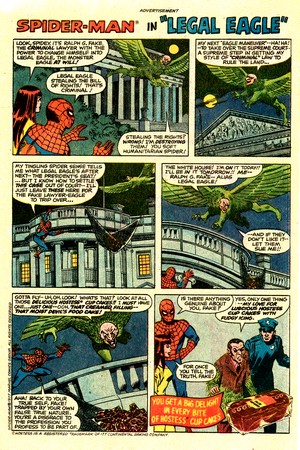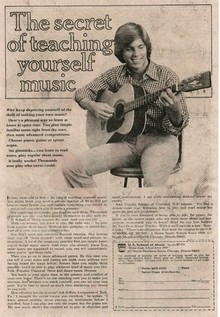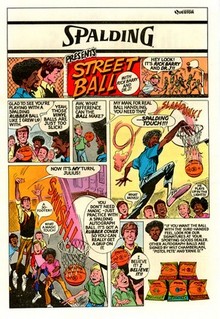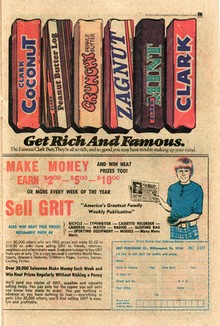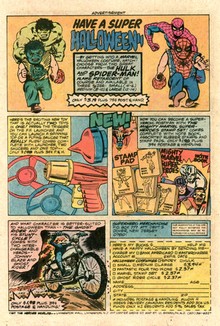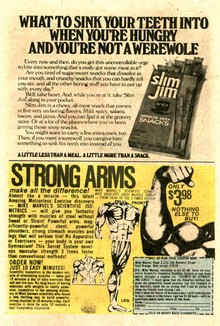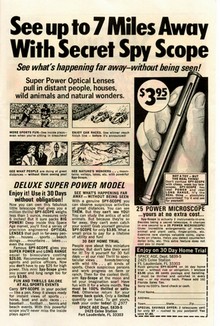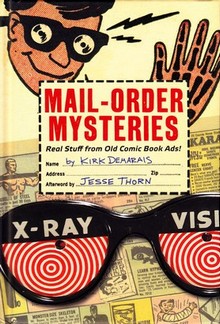 |
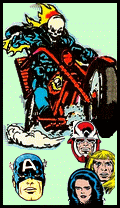 |
|
 SPOTLIGHT
ON
SPOTLIGHT
ON
CAPTAIN
AMERICA, GHOST RIDER &
THE ETERNALS
INSIDE
A
DECEMBER
1977 MARVEL MULTI-MAGS
|
|
|
|
| |
CAPTAIN AMERICA #216
GHOST RIDER #27
ETERNALS #18
|
|
 |
|
| |
|

|
|
| |
| By the mid-1970s, Marvel
had fully embraced the marketing concept of selling
multiple comic books packaged in a sealed plastic bag to
a customer base in supermarkets and department store
chains which comic books could hardly reach otherwise. |
| |
| This example of a
MARVEL MULTI-MAGS features three titles from
the December 1977 cover date run (meaning they
were actually on sale in September 1977):
Captain
America #216, Ghost Rider #27, and Eternals
#18.
Selling for 99¢
it
provides an interesting
comparison to another
December 1977
MARVEL MULTI-MAGS (which we shall call Multi-Mags
77-12A).
Although both contained
three titles priced at 35¢ each, the
MARVEL
MULTI-MAGS
shown here (let's call it
Multi-Mags 77-12B) sold for
the aforementioned 99¢, whereas
77-12A sold for 89¢. Evidently, there was a 10¢ increase
between the two, which can even be narrowed down
to one week: Multi-Mags 77-12A contained three
titles that went on sale September 6th 1977,
whereas Multi-Mags 77-12B contained three titles
that went on sale 13th September
1977.
Between
June and October 1977, Marvel experimented with a
5¢ price increase (from 30¢ to 35¢), which came
into final effect with the November 1977 cover
date run. Marvel accordingly also adjusted the
price of its
MARVEL MULTI-MAGS
(the last time this happened was between July and
August 1976, when the price went up from
"3
for 74¢" to "3 for 89¢",
also following an increase of an individual
issue's price from
25¢ to 30¢,
reducing the bargain
compared to the newsagent
total of $1.05 for the same three comic books
(sales tax at the department store checkout would
gobble up that saving even further). At least it
was still more than buyers could expect in the
early 1970s, when comicpacks only sold for 1¢
less
than the total of the cover prices.
There
is no general rule to state what shape/grade the
comic books in a
MARVEL MULTI-MAGS (or any
other comic pack for that matter) will be in.
During their 40+ years of storage, a lot of
things can go wrong. Some of these will only
affect the plastic bag, others might not harm the
packaging as much as the contents. As a result,
almost any combination is possible: you can have
a polybag displaying lots of wear but perfect
comic books inside (meaning it was mostly stored
in a dark and cool place but at some time took
some soiling or slight mechanical abrasion), but
you can just as well have a near pristine polybag
holding comic books showing substantial paper
degradation (indicating the bag was stored well
but exposed to light and excessive warmth for an
extended period of time).
The polybag of this December
1977
MARVEL MULTI-MAGS is
rather clean in comparison to some packagings of
the same period and also shows no discernible
wear. The same holds true for the three comic
books inside which proved to be in excellent
overall condition: pristine covers with perfect
gloss and shine, perfectly flat and tight
(without any spine stress) with no creases,
maintaining
sharp edges and off-white pages.
One
aspect strongly in evidence
throughout
all of the three issues, however, is the
"dirty" printing found every now and
then in 1970s comic books. As the print run
neared its target number of copies, it often
started to produce smudges and streaks, which
were only made worse by the cheap newsprint
paper. In
addition, the stapling wasn't always properly
centreed either in those days; the staples of the
copy of Eternals #18 are slightly
off-centre in this case but - much more
importantly -pristine.
|
|
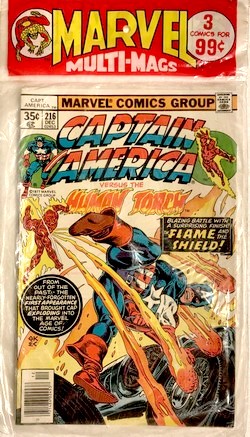
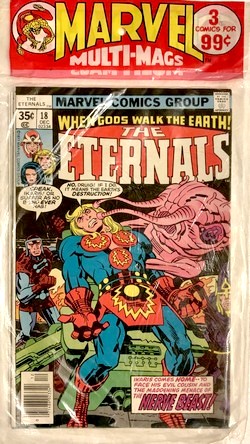
|
|
| |
| Issues of Captain America were
to be found fairly regularly in
MARVEL MULTI-MAGS, and several issues of Jack Kirby's Eternals
can be found throughout Marvel's comicpacks of the
mid- to late-1970s. The title standing out a bit in this
case is Ghost Rider, who only made very rare
appearances in the MARVEL
MULTI-MAGS -
possibly considered one of the less "kids (and
therefore parents/grandparents) friendly" titles. |
| |
| But no matter the
frequency - no titles had permanent slots in the MARVEL MULTI-MAGS, so missing out on the
continuation of a storyline was a possibility with some
titles (e.g. Captain America and Eternals)
and all but certain with others (e.g. Ghost Rider).
On top of this, the continuity of the Marvel Universe of
the 1970s was such that storylines usually evolved over
more than one issue, so that having one single issue of a
title would possibly provide for an entertaining read but
also most likely end on a cliffhanger - to be resolved in
the next issue. This
didn't exactly make the MULTI-MAGS
an ideal way of getting your Marvel comic book fix. However, one needs to bear in mind that
this was a common fate of the average comic book reader
in the 1970s Bronze Age, whether his or her comic books
came packaged in a plastic bag or as single issues from a
display or spinner rack. Back in those days, an
uninterrupted supply of specific titles simply was not
guaranteed. Not worrying too much about possible gaps in
storylines became something of a routine - besides, you
would usually get a recap of what had happened so far on
the first page. So all in all it simply was a part of
being a comic book fan in the 1970s - just as the monthly
Bullpen Bulletins and the in-house advertising were.
|
| |
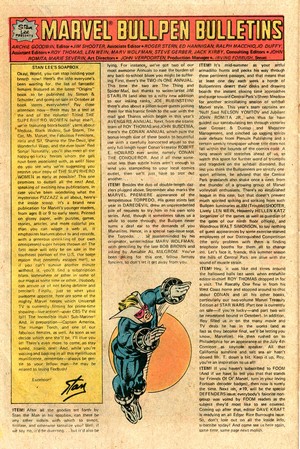 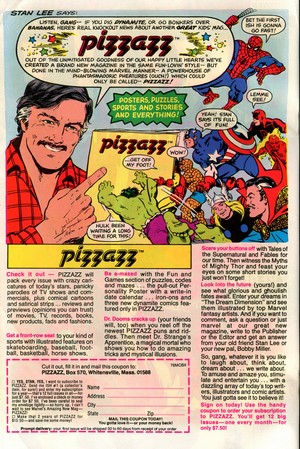 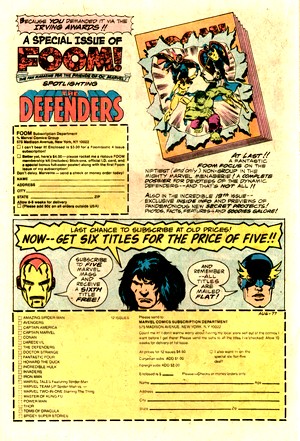 |
| |
| The Bullpen Bulletin for the
December 1977 cover date publication cycle was edited by
Archie Goodwin and featured the usual ITEM!
bullet points while also including Stan Lee's Soapbox,
all of which of course were frequently used to plug new
titles and products. |
| |
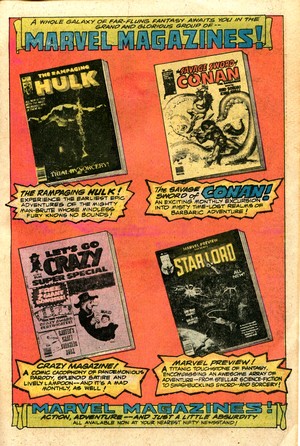
|
|
In
this case, Stan Lee was blowing the
trumpet for another upcoming Simon &
Schuster book (along the successful lines
of Origins of Marvel Comics and Bring
on the Bad Guys), this time
featuring The Superhero Women. This was followed by
another plug for Pizzazz, "a
brand new publication for Marvel's
younger readers, from ages 8 to 9 to
early teens" (as Stan Lee put
it); it was also pushed by an additional
full page ad on the inside cover of all
three titles contained in this
MARVEL
MULTI-MAGS (Pizzazz
ran from 1977 to 1979 for a total of
16 issues, featuring mostly articles
about popular movies and rock stars as
well as comic strips and puzzles).
"After
all the goodies set forth by Stan the Man
in his soapbox, can there be any other
tidbits with which to tempt, titillate
and otherwise tantalize you?"
Archie Goodwin asked at the outset of the
first ITEM! bullet point, but of
course that was only a rhetorical
question as he went on to tell readers
about a handful of Annuals (Two-In-One,
Avengers and Conan) as
well as Torpedo's first solo appearance
in Marvel Premiere #39, rounded
off by mentions of the House of Idea's
softball team and a visit to the Bullpen
by Roy Thomas (who had joined the growing
number of comic book creators moving out
to the West Coast by then).
Two pages were
used in all three titles for placing
in-house advertisements (which Marvel
always used to great advantage to
sprinkle a little extra of their
incomparable House Style
throughout its comic books).
|
|
|
| |
| One such page devotes one half
to the usual subscription and the other half to "two
more Giant-Size Summer Specials on sale now" (riding
on the tail-end of summer, given that all three comic
books in this MARVEL
MULTI-MAGS went on
sale the second week of September), while the other
advertised four of Marvel's magazine-format publications. |
| |
| |
|
| |
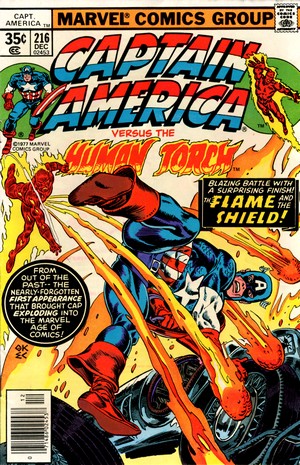
|
|
CAPTAIN
AMERICA #216
December 1977
(monthly)
On Sale: 13 September 1977
Editor
- Roy Thomas
Cover - Gil Kane (pencils) & Ernie
Chan(inks)
"The Human Torch
meets... 'Captain America'!" (18 pages)
Story - Stan
Lee
Pencils - Jack Kirby
Inks - Dick Ayers
Lettering - Sam Rosen
Reprinted
from Strange Tales #114
(November 1963)
Synopsis
! SPOILER ALERT !
Johnny Storm attends an antique
car show since it boasts an appearance of
Captain America and he doesn't want to
miss seeing his childhood idle. When
thieves try to rob the organizers he
foils their plans as the Human Torch,
together with Captain America. However,
Cap is acting strangely, and later that
night we witness him springing the crooks
out of jail.
|
|
|
| |
| The Torch learns that Captain America was behind
the whole thing all the time, and - after a chase across
town - unmasks him as not being Cap at all but rather the
Torch's old foe the Acrobat. Once all is put to rest,
Johnny wonders what became of the real Captain America. |
| |
| Apart from
a new splash page (scripted by Roy Thomas,
pencilled by Dave Cockrum, inked by Frank Giacoia
and lettered byIrv Watanabe) which serves to
introduce and frame the story, Captain
America #216 is entirely made up of reprint
material from Strange Tales #114
(November 1963).
Although
significant in terms of comic book history (this
was the first appearance of "Captain
America" - albeit an impostor - since the
Golden Age and somewhat paved the way for Stan
Lee bringing him back into the fold of Marvel's
1960s superheroes a few months later in Avengers
#4, March 1964), not all readers at the time may
have appreciated this dip into the past.
If that were so, then it
was probably somewhat linked to the fact that
these blasts from the past had started to appear
rather often and regularly.
|
|
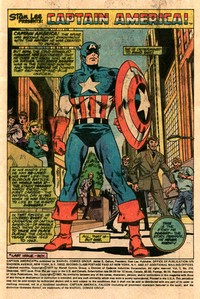 |
|
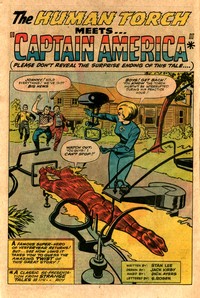 |
|
| |
| Marvel would often refer to the phenomenon as the
"deadline doom". In somewhat more prosaic
terms, Marvel was quite simply overextending its creative
staff by putting out more and more material, and the
bottom line was that the slightest incident could derail
the material needed for a title's next issue from getting
to the printers in Sparta, Illinois, on time. |
| |
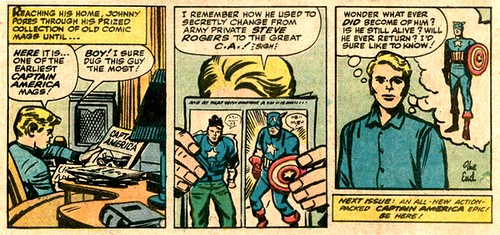 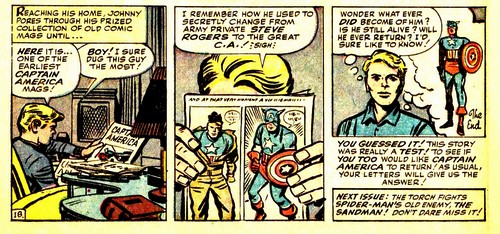 |
|
The first such incident
concerned the April 1969 cover date
issue of
Dr
Strange #179 because artist Gene Colan had caught
the flu and no replacement was on hand (Stan Lee
actually shared this piece of information), but by the mid-1970s
missing deadlines became a frequent problem - so
much so that it was often glossed over by
trumpeting the reprint material as a special
treat of sorts. Comparing the original from Strange Tales #114 to the reprint in Captain America #216
reveals that only few alterations were made. One
point which did receive the attention of whoever
oversaw this issue was changing Cap's tights from
the original red to the now canonical blue.
Attention to detail
wasn't always a strong point of "deadline
doom" inserts, but in this case it was
actually present.
Also of note is the
little notice in the final panel, missing from
the reprint for obvious reasons, where Stan Lee
is asking readers about their views on bringing
back Cap. Well, that question had of course been
well and truly answered by the time Captain
America #216 hit news stands and
MARVEL
MULTI-MAGS.
|
|
| |
| Ultimately it's hard to say if readers were okay with
Kirby's rather old school Cap in comparison to Cockrum's
imposing rendition on the splash page or not. In any case
there would always be another issue of Captain America in another
MARVEL
MULTI-MAGS. |
| |
| |
|
| |
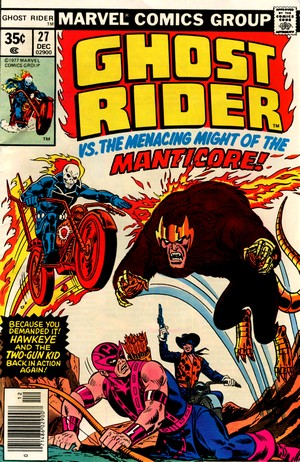
|
|
GHOST
RIDER #27
December
1977
(bi-monthly)
On Sale: 13 September 1977
Editor -
Archie Goodwin
Cover - Ron Wilson (pencils)
& Frank Giacoia (inks)
"At
the Mercy of the Manticore!" (17 pages)
Story - Jim
Shooter
Pencils - Don Perlin
Inks - Dan Green
Lettering - Francoise Mouly
Colouring - Denise Wohl
Synopsis
!
SPOILER ALERT !
Johnny Blaze a.k.a. the
Ghost Rider is on the road
fleeing from his old life when
his bike starts to act up. He
pulls into a ranch for repairs
where he meets up with Hawkeye
and Two-Gun Kid just in time to
help battle the Manticore. The
villain's identity is (and
remains) unclear, but he seems
intent on retrieving the Hellcat
costume, as used by Patsy Walker,
for the Brand Corporation (whose
creation the Manticore appears to
be).
|
|
|
|
| |
| The Manticore had been
spying on Clint Barton a.k.a. Hawkeye and the Two-Gun Kid
at the ranch they were both working at, but didn't bank
on the Ghost Rider making an appearance, saving the
Two-Gun Kid from being decapitated by Manticore, who is
ultimately brought down by one of Hawkeye's well-aimed
arrows. |
| |
| Jim
Shooter's story ultimately coughs up more guest
stars (two) than thrills, and Don Perlin's
artwork is either spot on or terribly off
throughout the entire issue, but in the end the
Ghost Rider is one of those Marvel characters
which are so strong and have such a conceptual
and visual quality that they can somehow carry
even the most uneventful and mediocre plots. In
this case, neither the plot nor the villain
create any real interest, and at times both even
get dangerously close to being totally cheesy and
even utterly ridiculous - which is somewhat
surprising given that the Manticore is a
legendary Persian creature (not unlike the
Egyptian sphinx) with the head of a human and the
body of a lion, sporting a tail of venomous
spines.
Branded as the
most supernatural superhero of all, Marvel
launched the Ghost Rider in Marvel Spotlight #5
(a tryout title which had previously already
proven a successful launchpad for the Werewolf
by Night series) in August 1972. Johnny
Blaze, a motorcycle stunt performer in a
travelling circus, sold his soul to what he
believed to be the devil in order to save the
life of his stepfather - transforming, as a
result, into a leather-clad skeleton with a skull
cloaked in a sheath of flame, riding a fiery
motorcycle and wielding blasts of hellfire from
his skeletal hands.
|
|
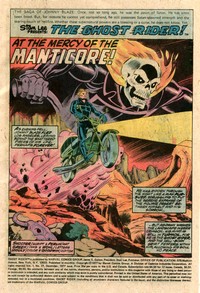 |
|
| |
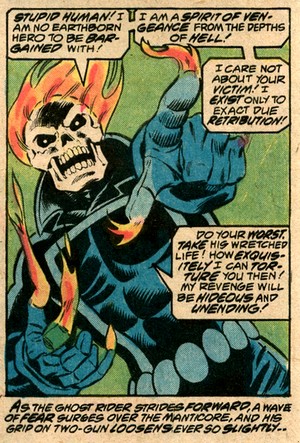 |
|
The
Ghost Rider's first drive around the block was
supervised by editor Roy Thomas, writer Gary
Friedrich and artist Mike Ploog - with the
original authorship of the character remaining a
matter of dispute (but claimed by Gary Friedrich
who took Marvel to court on the matter).
Featuring in two big budget
movies in 2007 and 2012 starring Nicholas Cage (a
comic book fan himself), the Ghost Rider hardly
ever appeared in
MARVEL MULTI-MAGS.
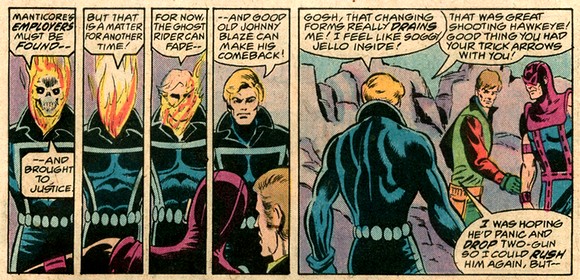
|
|
| |
| |
|
| |
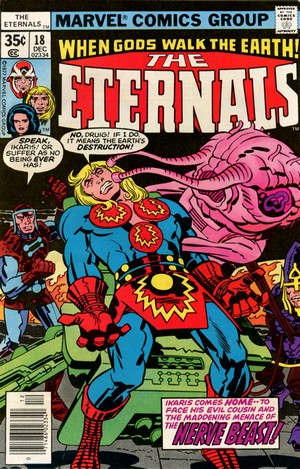
|
|
ETERNALS
#18
December
1977
(monthly)
On Sale:
13 September
1977
Editor -Jack Kirby &
Archie
Goodwin
Cover - Jack Kirby(pencils)
& Frank Giacoia(inks)
"To
Kill a Space God"
(17
pages)
Story -
Jack Kirby
Pencils -
Jack Kirby
Inks -
Mike Royer
Lettering -
Glynis Wein
Colouring -
Mike Royer
Synopsis
!
SPOILER ALERT !
Ikaris' evil cousin,
Druig, searches for the means to
destroy a Celestial and he learns
that the secret lies within
Ikaris.
Druig captures Ikaris and
uses a Nerve Beast to wrestle the
secret from Ikaris' mind. The
weapon, which can destroy a
Celestial, lies within the
Pyramid of the Winds.
|
|
|
|
| |
| This is the second to last
issue of Eternals; the series would be cancelled
after issue #19 (January 1978). In order to understand
the Eternals, one needs to understand the enormous amount
of Jack Kirby's personal and professional history tied
into it. Kirby left Marvel Comics in 1970 for DC
Comics, increasingly angered by what he perceived to be
an intentional and continuous denial of credit for his
share in creating much of the Marvel Universe. He had
enough of it, and DC promised him not only full credit
but also full artistic freedom. The result was Kirby's
"Fourth World" metaseries, a blend of classic
mythology and science fiction. For some it was the
ultimate comic book saga, stretching across titles such
as New Gods, Forever People and Mister
Miracle; for others it was too convoluted and
confusing, and they seemed to be in the majority, as
Kirby's work didn't sell near as well as DC needed it to
- including more traditional fare such as Superman's
Pal Jimmy Olsen (which, however, "the
King" used as a launch pad for many of his Fourth
World concepts in order to give them greater exposure to
potential buyers), a title he worked on until April 1972.
"The sales of the Kirby issues plummeted
and we hastened to revert to our traditional artists."
(Carmine Infantino, in Stump, 1996)
As the number of cancellations of Fourth World titles
grew, so did Kirby's disappointment with DC, and after
the axe came down on Mister Miracle in late
1973, he wasn't even sure he would sit out his contract.
In the end he did, and so it wasn't until Spring 1975
that Jack Kirby once again started to work for Marvel. In
return for this industry scoop, "the King"
essentially just wanted to be left alone to write and
edit his own stories with no co-plotters or tie-ins with
other titles done by other people. Captain America and
the Black Panther were the only Marvel characters
(co-created by himself) that Kirby agreed to return to,
and he kept them deliberately detached from Marvel
continuity - which felt increasingly weird to many Marvel
fans (Gartland & Morrow, 2013).
|
| |
| In terms of new concepts, Kirby
then started working on The Eternals,
which was thematically similar to his DC New
Gods but actually took its core inspiration
from Swiss author Erich von Däniken's Chariots
of the Gods which made the both fascinating
and controversial claim that Earth had been
visited by aliens in the past and that evidence
of this could be found in artefacts and the
mythologies of ancient civilizations. Working
on this premise, Kirby postulates such an alien
visit in our prehistoric past. Through genetic
experimentations these "Celestials"
create three distinct species: Earth's humans,
the "Deviants" (whose genes are so
unstable that every one of them is grotesquely
different and they all have lived on the bottom
of the ocean for centuries), and the
"Eternals" (undying and beautiful
humanoids with superhuman mental gifts).
|
|
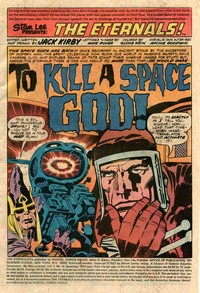 |
|
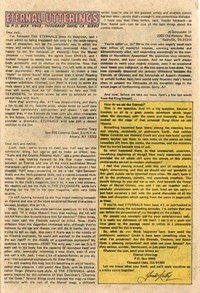 |
|
| |
| It was once again a typically high-flying Kirby
concept, accompanied by artwork of complex machinery, but
at least to start with it seemed to work well enough.
Ultimately, however, his work came across as being too
detached from what the average reader would expect. And
since Marvel Comics had always been about finding
"the formula that sells", this became a
problem, aggravated by the fact that by that time Kirby
was living and working in California and the Marvel
offices were in New York. Communication was slow, and it
seems that opinions on Kirby's work started to drift to
extremes - some still admired it, while others simply
couldn't stand it (Gartland & Morrow, 2013). Kirby
was told to link the Eternals to the Marvel Universe,
which he did (although explaining the presence of the
Hulk as an instance of an android robot, allowing him to
still keep things somewhat apart), but an increasing
amount of corrections of dialogue made in NYC (with Kirby
only finding out when he saw the printed copies) made the
situation more and more difficult. More and more negative
letters from readers were received (and published).
Gartland & Morrow (2013) claim that this was to a
degree fabricated by people inside Marvel wanting to
bully Kirby out, while Howe (2012) quotes an unnamed
Marvel staffer who snuck self-penned positive letters
into Kirby's Captain America issues to try and
counter-balance all the negative feedback pouring in.
The entire atmosphere at Marvel had changed, and the
growing number of individuals involved seemingly all had
their own private agendas to pursue (Howe, 2012). When
Kirby's contract came up for renewal in April 1978, Stan
Lee made it clear that he only wanted Kirby's artwork and
no more of his scripting. Not surprisingly, Kirby left
after only three years at Marvel (during which he also
worked on titles such as 2001: A Space Odyssey, Machine
Man and Devil Dinosaur) and went to work
for the animation industry, never to return to Marvel
again.
It is probably fair to say that all of Kirby's 1970s
work is something of an acquired taste, but the Eternals
are comparatively accessible and make for entertaining
reading most of the time (which may also explain why they
are slated to join the Marvel Cinematic Universe in
November 2021). In terms of
MARVEL MULTI-MAGS, copies of the Eternals
appeared frequently, and although the actual evidence
continues to present some holes in the data, the
MULTI-MAGS may even have carried a
complete and full run of all 19 issues.
|
| |
| |
|
| |
No 1970's Marvel comic book
was, of course, without third party advertising, some of
which was "okay" (mostly if it featured Marvel
characters) and some of which was, well, something else
(such as the infamous flea market ads promising anything
and everything). All three titles included in this
December 1977 Multi-Mag carried almost exactly the same
ads, some of which are illustrated here.
If you've ever wondered
what those hyped-up mail-order items really looked like, Kirk Demarais'
book Mail Order Mysteries is a real treat, providing
entertaining denouéments and (hopefully) a strange satisfaction
that you never did get around to ordering some of those items, all of
which provided the purchaser with a sense of disappointment at best.
|
| |
|
| |
| |
|
| |
|
| |
| BIBLIOGRAPHY GARTLAND Mike & John
Morrow (2013) "You can't go home again - Kirby's 1970s
return to the "snake pit" of Marvel Comics", in Jack Kirby
Collector #29
HOWE Sean (2012) Marvel Comics -
The Untold Story, Harper Collins
STUMP Greg (1996) “Infantino
Raises Questions About CBG Letters Policy Following Kirby
Controversy Flare-Up”, in The
Comics Journal #191 (November 1996)
|
| |
|
| |
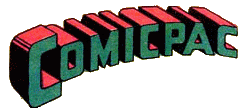
More on comic
packs
|
| |
|
| |

(c) 2021
uploaded to the web
8
March
2021
minor updates 5 October 2022
|
| |
|
| |
|






















